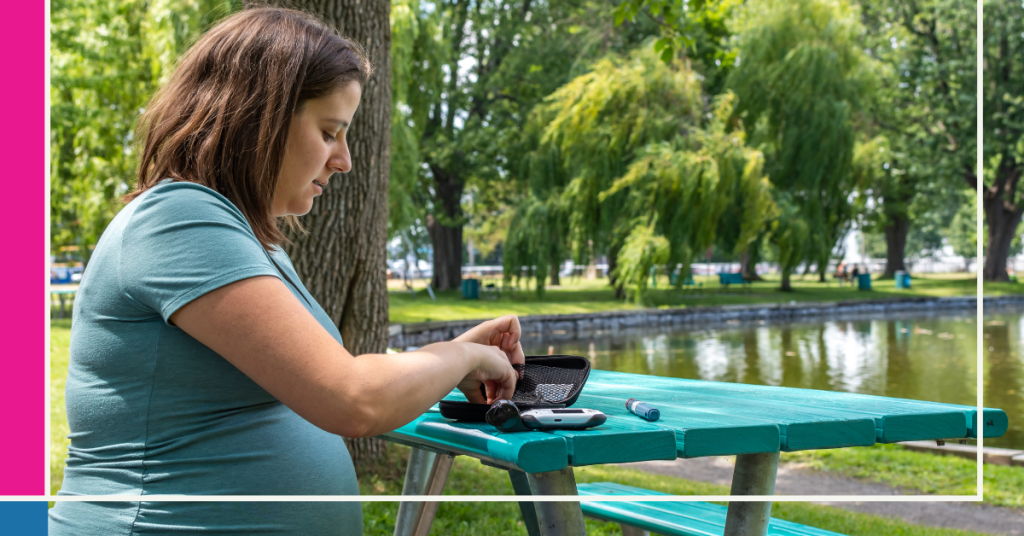Gestational diabetes walking is a powerful tool for managing blood sugar levels during pregnancy. Physical activity, especially walking, plays a crucial role in maintaining health and well-being for expectant mothers.
In this article, we’ll explore how walking can help control blood sugar, providing you with five proven tips to make the most of your walks. You’ll learn why walking is beneficial, how it compares to other exercises like cycling, and practical advice to incorporate it into your routine. Let’s get started on a journey to better health for you and your baby.
At Midlife Runners Paradise, our mission is to foster resilience, health, and joy through our gentle running framework. We believe in redefining wellness for individuals over 40, proving it’s never too late to enhance one’s health and happiness.
Gestational Diabetes Walking: Why It Matters
Gestational diabetes walking is an essential strategy for managing blood sugar levels during pregnancy. Walking, as a form of physical activity, can significantly impact how your body uses insulin, making it easier to control glucose levels.
One of the main benefits of walking for gestational diabetes is its ability to improve insulin sensitivity. When you walk, your muscles use glucose for energy, which helps lower blood sugar levels. This process reduces the need for your body to produce or use additional insulin, making it easier to maintain healthy glucose levels.
Studies have shown that regular physical activity, like walking, can help manage gestational diabetes more effectively than diet alone. For example, a study published in the American Journal of Obstetrics and Gynecology found that moderate exercise, such as brisk walking, can significantly reduce blood sugar levels in pregnant women with gestational diabetes.
In addition to blood sugar control, walking offers other health benefits. It helps maintain a healthy weight, reduces stress, and improves overall cardiovascular health. These factors are crucial for both the mother and the developing baby, ensuring a healthier pregnancy and reducing the risk of complications.
By incorporating walking into your daily routine, you can take proactive steps towards better managing gestational diabetes. Whether it’s a short walk after meals or a longer stroll in the morning, every step counts towards improving your health and well-being.
1. Walking Improves Insulin Sensitivity
Gestational diabetes walking significantly enhances insulin sensitivity, which is crucial for managing blood sugar levels effectively. When you walk, your muscles actively use glucose for energy, which helps lower the amount of sugar in your bloodstream. This natural process reduces the body’s demand for insulin, making it easier to maintain stable blood sugar levels.
The mechanism behind this improvement involves the activation of muscle cells. During physical activity, your muscles contract and increase their glucose uptake, which means more sugar is being used for energy rather than remaining in the blood. This enhanced glucose uptake helps improve insulin sensitivity, making your body more efficient at using the insulin it produces.
To maximize these benefits, it’s important to incorporate regular walking into your routine. Here are some tips to help you get started:
- Walk After Meals: A 10-15 minute walk after meals can help reduce post-meal blood sugar spikes. This simple habit can make a significant difference in managing your gestational diabetes.
- Consistency is Key: Aim for at least 30 minutes of walking most days of the week. Consistent activity is more beneficial than occasional long walks.
- Monitor Your Intensity: Moderate-intensity walking is generally recommended. You should be able to talk but not sing during your walk. Adjust your pace to stay within this range.
- Stay Hydrated: Drink plenty of water before, during, and after your walk to stay hydrated and support your body’s metabolic processes.
- Wear Comfortable Shoes: Proper footwear can prevent injuries and make your walking experience more enjoyable.
By following these tips, you can effectively use walking to enhance your insulin sensitivity and better manage your gestational diabetes. Regular walking not only helps control blood sugar but also contributes to overall health and well-being during pregnancy.
2. Walking Helps Maintain a Healthy Weight
Gestational diabetes walking is a crucial component in maintaining a healthy weight, which directly impacts blood sugar control. Managing weight during pregnancy is essential because excess weight can lead to increased insulin resistance, making it harder to regulate blood sugar levels.
Walking, a low-impact and accessible form of exercise, helps burn calories and promotes a healthy weight. Regular physical activity increases your metabolism, which helps your body use glucose more efficiently. This process is vital for those with gestational diabetes, as it helps keep blood sugar levels within a healthy range.
Maintaining a healthy weight through walking has multiple benefits:
- Reduces Insulin Resistance: By helping control weight, walking reduces the body’s insulin resistance, making it easier to manage blood sugar levels.
- Supports Cardiovascular Health: Regular walking improves heart health, which is important for overall well-being during pregnancy.
- Boosts Energy Levels: Walking increases stamina and energy, making it easier to stay active throughout the day.
To incorporate walking into your daily routine, consider these practical tips:
- Set Realistic Goals: Start with manageable goals, like a 10-minute walk after each meal, and gradually increase the duration as you become more comfortable.
- Find a Walking Buddy: Walking with a friend or family member can make the activity more enjoyable and help you stay motivated.
- Choose Scenic Routes: Select pleasant and safe routes that you enjoy. This can make your walking routine something to look forward to.
- Track Your Progress: Use a pedometer or a mobile app to track your steps and progress. Seeing your improvements can be a great motivator.
- Stay Consistent: Aim for at least 30 minutes of walking most days of the week. Consistency is key to reaping the benefits of walking.
By integrating regular walking into your lifestyle, you can maintain a healthy weight and effectively manage gestational diabetes. Walking not only helps control blood sugar but also contributes to overall health and well-being during pregnancy.
3. Walking Reduces Stress and Promotes Mental Health
Stress has a significant impact on gestational diabetes, as it can lead to elevated blood sugar levels. When stressed, the body releases hormones like cortisol, which can increase glucose production and reduce insulin sensitivity. This makes managing gestational diabetes more challenging.
Gestational diabetes walking is an effective way to combat stress and enhance mental well-being. Walking, as a form of exercise, stimulates the production of endorphins, the body’s natural mood lifters. These endorphins help reduce stress levels and promote a sense of calm and happiness.
Additionally, walking provides an opportunity to disconnect from daily pressures and enjoy a moment of peace. This can lead to improved mental clarity and a more positive outlook, both crucial during pregnancy.
To maximize the mental health benefits of walking, consider these tips:
- Practice Mindfulness: Combine walking with mindfulness practices such as focusing on your breathing, the rhythm of your steps, or the surrounding environment. This can enhance the calming effects of your walk.
- Choose Scenic Routes: Walking in nature or in pleasant surroundings can boost your mood and provide a sense of tranquility. Parks, trails, and waterfronts are great options.
- Listen to Relaxing Music or Podcasts: Enjoying soothing music or an interesting podcast can make your walk more enjoyable and help you relax.
- Set a Routine: Establish a regular walking schedule to create a sense of routine and stability, which can be comforting and reduce stress.
- Walk with a Friend: Social interaction during walks can provide emotional support and make the activity more enjoyable.
By incorporating these practices into your walking routine, you can effectively reduce stress and improve your mental health, which in turn helps manage gestational diabetes. Walking not only supports physical health but also nurtures your mind, creating a holistic approach to well-being during pregnancy.
4. Walking Encourages Better Sleep
Quality sleep is crucial for managing gestational diabetes, as poor sleep can negatively affect blood sugar levels. Lack of sleep can lead to increased insulin resistance and higher blood sugar levels, making it harder to control gestational diabetes.
Gestational diabetes walking can help improve sleep quality by promoting relaxation and reducing stress. Regular physical activity like walking helps regulate your body’s circadian rhythm, which is essential for a good night’s sleep. Additionally, walking can tire you out physically, making it easier to fall asleep and stay asleep.
Here are some tips to enhance sleep quality through walking:
- Walk at the Right Time: Try to walk earlier in the day, as evening walks might energize you and make it harder to fall asleep. Morning or afternoon walks are ideal for promoting better sleep.
- Maintain a Routine: Consistency is key. Establish a regular walking schedule to help regulate your sleep patterns and improve overall sleep quality.
- Create a Relaxing Pre-Sleep Routine: Complement your walking routine with relaxing activities before bed, such as reading or taking a warm bath. This can help signal to your body that it’s time to wind down.
- Ensure a Comfortable Sleep Environment: Make sure your bedroom is conducive to sleep. Keep the room cool, dark, and quiet. Comfortable bedding and a supportive mattress can also make a significant difference.
- Limit Caffeine and Screen Time: Avoid caffeine and electronic devices at least an hour before bedtime. These can interfere with your ability to fall asleep and stay asleep.
By incorporating regular walking into your daily routine, you can improve your sleep quality, which in turn helps manage gestational diabetes. Better sleep not only supports blood sugar control but also enhances overall health and well-being during pregnancy.
5. Walking vs Cycling for Diabetes Management
When it comes to managing gestational diabetes, both walking and cycling offer significant benefits. However, there are differences in effectiveness and practicality that may influence your choice.
Walking for Gestational Diabetes:
- Accessibility: Walking requires no special equipment and can be done almost anywhere, making it a convenient option for many.
- Low Impact: Walking is gentle on the joints, which is particularly beneficial during pregnancy. It’s a safe way to stay active without putting too much strain on your body.
- Consistency: Walking can easily be incorporated into your daily routine. Short walks after meals can help regulate blood sugar levels and improve insulin sensitivity.
Cycling for Gestational Diabetes:
- Cardiovascular Benefits: Cycling can provide a more intense cardiovascular workout compared to walking. This can help improve overall cardiovascular health and enhance glucose metabolism.
- Lower Body Strength: Cycling can help build and maintain lower body strength, which can be beneficial for overall fitness.
- Variety: For those who enjoy a more dynamic and fast-paced activity, cycling can be a more engaging form of exercise.
Recommendations:
- Personal Preference: Choose the activity you enjoy the most. Consistency is key in managing gestational diabetes, so it’s important to pick an exercise you’re likely to stick with.
- Combination Approach: Consider incorporating both walking and cycling into your routine to enjoy the benefits of both. For example, you could walk after meals and cycle a few times a week.
- Consult Your Doctor: Before starting any exercise program, it’s important to consult with your healthcare provider to ensure the activities are safe and appropriate for your individual circumstances.
Both walking and cycling are effective for managing gestational diabetes. By choosing the activity that best fits your lifestyle and preferences, you can maintain a healthy routine that supports blood sugar control and overall well-being.
Conclusion
In conclusion, incorporating walking into your daily routine can play a significant role in managing gestational diabetes. We’ve explored five proven ways that walking helps control blood sugar: improving insulin sensitivity, maintaining a healthy weight, reducing stress, promoting better sleep, and comparing walking to cycling for diabetes management.
Gestational diabetes walking not only aids in blood sugar control but also enhances overall well-being. By following these tips and integrating regular walking into your lifestyle, you can better manage your gestational diabetes and improve your health.
Remember, consistency is key. Start with manageable walks, gradually increase your duration and intensity, and always consult with your healthcare provider to ensure that your exercise regimen is safe and effective for your specific needs. At Midlife Runners Paradise, we are committed to supporting your journey towards better health and happiness.





